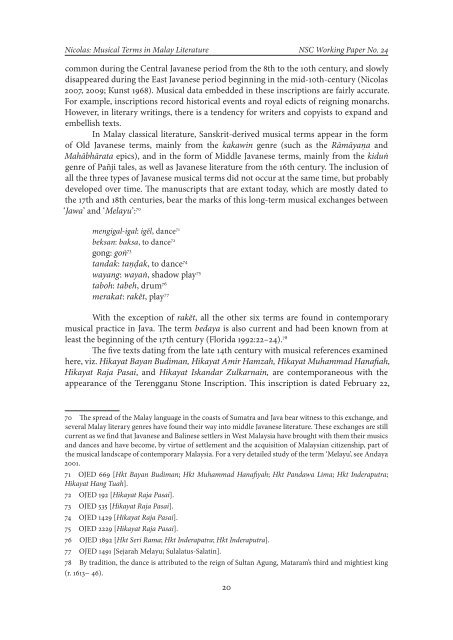2k2ADzp
2k2ADzp
2k2ADzp
Create successful ePaper yourself
Turn your PDF publications into a flip-book with our unique Google optimized e-Paper software.
Nicolas: Musical Terms in Malay Literature NSC Working Paper No. 24<br />
common during the Central Javanese period from the 8th to the 10th century, and slowly<br />
disappeared during the East Javanese period beginning in the mid-10th-century (Nicolas<br />
2007, 2009; Kunst 1968). Musical data embedded in these inscriptions are fairly accurate.<br />
For example, inscriptions record historical events and royal edicts of reigning monarchs.<br />
However, in literary writings, there is a tendency for writers and copyists to expand and<br />
embellish texts.<br />
In Malay classical literature, Sanskrit-derived musical terms appear in the form<br />
of Old Javanese terms, mainly from the kakawin genre (such as the Rāmāyaṇa and<br />
Mahābhārata epics), and in the form of Middle Javanese terms, mainly from the kiduṅ<br />
genre of Pañji tales, as well as Javanese literature from the 16th century. The inclusion of<br />
all the three types of Javanese musical terms did not occur at the same time, but probably<br />
developed over time. The manuscripts that are extant today, which are mostly dated to<br />
the 17th and 18th centuries, bear the marks of this long-term musical exchanges between<br />
‘Jawa’ and ‘Melayu’: 70<br />
mengigal-igal: igĕl, dance 71<br />
beksan: baksa, to dance 72<br />
gong: goṅ 73<br />
tandak: taṇḍak, to dance 74<br />
wayang: wayaṅ, shadow play 75<br />
taboh: tabeh, drum 76<br />
merakat: rakĕt, play 77<br />
With the exception of rakĕt, all the other six terms are found in contemporary<br />
musical practice in Java. The term bedaya is also current and had been known from at<br />
least the beginning of the 17th century (Florida 1992:22–24). 78<br />
The five texts dating from the late 14th century with musical references examined<br />
here, viz. Hikayat Bayan Budiman, Hikayat Amir Hamzah, Hikayat Muhammad Hanafiah,<br />
Hikayat Raja Pasai, and Hikayat Iskandar Zulkarnain, are contemporaneous with the<br />
appearance of the Terengganu Stone Inscription. This inscription is dated February 22,<br />
70 The spread of the Malay language in the coasts of Sumatra and Java bear witness to this exchange, and<br />
several Malay literary genres have found their way into middle Javanese literature. These exchanges are still<br />
current as we find that Javanese and Balinese settlers in West Malaysia have brought with them their musics<br />
and dances and have become, by virtue of settlement and the acquisition of Malaysian citizenship, part of<br />
the musical landscape of contemporary Malaysia. For a very detailed study of the term ‘Melayu’, see Andaya<br />
2001.<br />
71 OJED 669 [Hkt Bayan Budiman; Hkt Muhammad Hanafiyah; Hkt Pandawa Lima; Hkt Inderaputra;<br />
Hikayat Hang Tuah].<br />
72 OJED 192 [Hikayat Raja Pasai].<br />
73 OJED 535 [Hikayat Raja Pasai].<br />
74 OJED 1429 [Hikayat Raja Pasai].<br />
75 OJED 2229 [Hikayat Raja Pasai].<br />
76 OJED 1892 [Hkt Seri Rama; Hkt Inderapatra; Hkt Inderaputra].<br />
77 OJED 1491 [Sejarah Melayu; Sulalatus-Salatin].<br />
78 By tradition, the dance is attributed to the reign of Sultan Agung, Mataram’s third and mightiest king<br />
(r. 1613– 46).<br />
20


